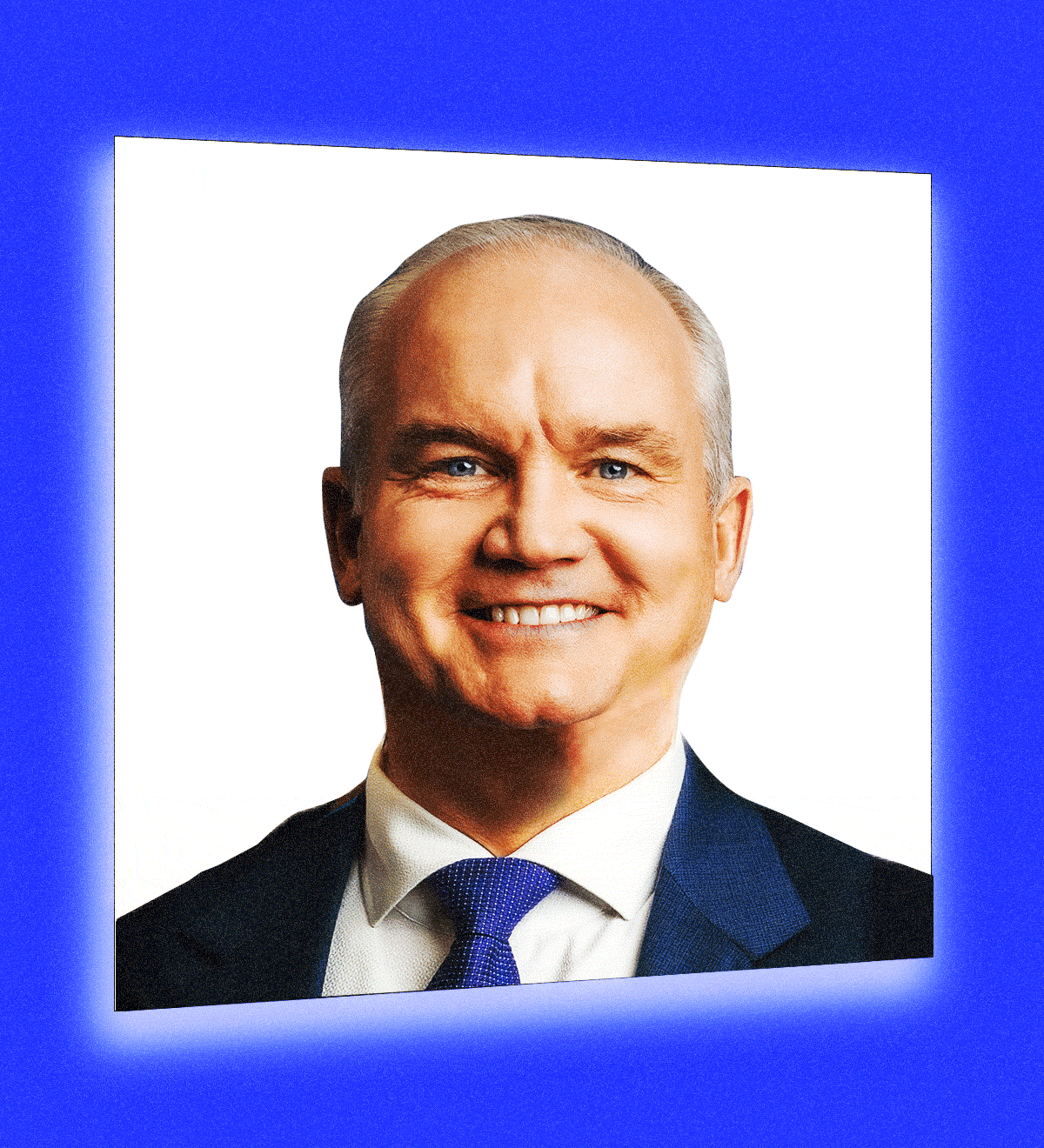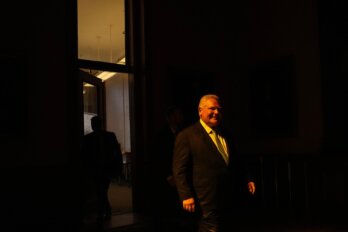On the first full day of the 2021 federal election race, the Conservative Party released its platform, and I found myself wondering, Why is Erin O’Toole trying so hard to convince me that he’s hot?
Triggering my reaction—and, judging by the firehose of jokes unleashed on social media, I was definitely not alone—was the document’s unusual cover. Rather than the usual corporate graphics, the document had been mocked up in the style of a glossy magazine, with O’Toole doing his best imitation of Burt Reynolds. Poured into a snug blue T-shirt, arms folded across his chest, he flashes a confident smile beneath a set of bedroom eyes.
And, in case anyone missed the message about this man being a masculine man of irrefutable manliness, the caption beneath his photo helpfully informs readers that Erin O’Toole should be regarded as “The Man with the Plan.”
But why? Why this makeover for the blue-suited former cabinet minister who never before seemed much concerned with appearances? Why this sudden, almost plaintive appeal to have Canadians see O’Toole as not just masculine but attractive? For years, the Conservatives and other critics have derided Justin Trudeau as the “selfie” prime minister. Have they decided that, in order to beat him, they’ve got to join him?
For nearly three decades, I’ve worked as an adviser to some of Canada’s most senior politicians and change makers, helping them shape their communications strategies. It’s undeniable that telegenic leaders find it easier to be heard and even admired. People believed that John F. Kennedy won debates because of his handsome features. David Peterson swept Ontario in the mid-1980s with the help of an updated haircut and a bold red tie. Even Donald Trump, with his ridiculous roostering around, reminds us of the importance of projecting a distinctive public persona.
But electoral politics isn’t actually a beauty contest. At least not usually for men. No one ever shouted “Over here, Leo!” at Paul Martin or Stephen Harper. Sure, female leaders get a full dose of attention to their appearances and always have. Former environment and climate change minister Catherine McKenna was trolled as “Climate Barbie,” and Conservative MP Michelle Rempel Garner was labelled “unprofessional” for wearing a sleeveless white dress to Parliament.
Not dudes, though. They can win elections even if they look like a sack of yoghurt. Witness Boris Johnson—before his pandemic haircut.
My first instinct, therefore, was to chalk up O’Toole’s new look to vanity. He is, after all, frequently mistaken for being older than his main rival, Justin Trudeau. At forty-eight, he’s actually a little more than one year younger than the prime minister. Perhaps the spotlight’s glare has the middle-aged Conservative leader feeling a little sensitive about his appearance. As a pudgy fifty-something-year-old man, I find that understandable—but not necessarily strategic.
A favourite adage of mine says: if you want people to eat roast chicken, don’t set it next to lobster. And, let’s face it, as political figures go, Trudeau is the catch of the day. For more than half a decade, he’s been held up as the athletic ideal of postmodern masculinity: half woke and half smoke. In 2015, Vogue described him as “sexy, feminist and capable of balancing a baby in one hand.”
And, for O’Toole, the challenge doesn’t stop there. He has the NDP leader to contend with also.
Jagmeet Singh cuts a dramatic profile with his bespoke suits, fashionably coloured turbans, and striking beard. Only forty-two, he’s the youngest of the major party leaders and has established himself as the man to beat among voters thirty-five and under. Singh’s image is stylish and steeped in Gen Z norms: progressive, urbane, a TikTok master. And, like Trudeau, he’s caught the eye of the American media, having been featured in the pages of GQ. For the elegant modern male, there is no more authoritative endorsement.
It all leaves me wondering why the Conservative leader is trying to compete on this turf. Surely the wiser choice would be to persuade people to pick their next prime minister based on a different set of criteria—benchmarks against which O’Toole might more obviously compete, such as managerial competence or economic priority.
There is, however, a rational explanation for what the Conservatives are up to, one that is well grounded in established political practice. O’Toole could be pursuing what Dick Morris, adviser to Bill Clinton, referred to as “triangulation.”
The theory is simple: you adopt some of the policies or approaches of your opponents—not because you think you can necessarily outdo them but because you hope to neutralize them. For former president Clinton battling Republican Speaker Newt Gingrich in the 1990s, that meant championing some family-values talk and the three-strikes law. It didn’t make Clinton the preferred choice of the law-and-order crowd, but it blunted his vulnerability on those issues, allowing him to triangulate his candidacy between voters at one point and rivals at the other.
The whole goal of triangulation is to take issues off the table as matters of comparison, leaving voters to cast their ballots based on other, preferred points of cleavage. Since Clinton, it’s been widely used by other political leaders.
It may not be possible for O’Toole to win this game. But perhaps he’s decided to play along in order to offset the electoral threat.
Judith Taylor, an associate professor at the University of Toronto’s Women and Gender Studies Institute, has written widely about the politics of masculinity. Asked about O’Toole’s new strategy, she proposes an altogether different interpretation.
Taylor believes that O’Toole is deliberately creating his own “map” of masculinity—but not to neutralize his opponents’ advantage. She thinks he’s looking to beat them at their own game.
By drawing on a particular set of male tropes, Taylor argues, O’Toole is “positioning himself as the noncosmopolitan.” It’s a brand of male leadership, she suggests, that offers a contrast to the likes of not just Trudeau and Singh but other progressive recent world leaders: Barack Obama’s small-L liberal values and magnetic smile, Emmanuel Macron’s technocratic charm and pressed French cuffs.
O’Toole is composing an alternative male ideal, Taylor suggests. A kind of HGTV versus Esquire masculinity—the sort that shows up in a plain cotton tee instead of an expensive suit. A handyman, not a dandyman.
This notion also fits well with the pendulum-swing of politics. With his jazzy socks, manicured looks, and multilateral policies, Trudeau was practically bequeathed the mantle of global cosmopolitan champion by Obama after he left the White House. In 2019, the former president even urged Canadians to reelect Trudeau, saying, “The world needs his progressive leadership now.”
But Obama was elected in 2008, Trudeau in 2015, and Macron in 2017. Maybe O’Toole is reading the room and recognizing that, as seasons shift, people are open to change—in their government and, maybe, in their male iconography too.
Unsurprisingly, O’Toole colours his brand with a slight tinge of sepia. Taylor points to campaign appearances where the Conservative leader has emphasized a throwback checklist of male leadership qualities: military service, love of sports, blue-collar roots, and family values. At one stop in Hamilton, O’Toole tells the crowd he’s from a community like theirs with people just like them. “They love their city. They love its teams. And they love their country.”
Still, such nostalgia can be overdone. In the spring, an Instagram post showed the Conservative leader out after a run holding a “cold one” that he said his wife, Rebecca, had kept waiting for him. In response to those who deemed the message a touch retrograde, O’Toole posted another pic. But this time it was him—the man!—serving up a drink to his smiling wife.
These incidents serve only to reinforce the central point: since becoming Conservative leader, O’Toole has committed enormous energy to the way in which his masculinity is curated and presented.
Taylor half-laughingly welcomes this new, conscientious approach from O’Toole—not to mention Trudeau and Singh—as an odd sort of progress. “We’ve managed to democratize insecurity, in terms of gender identity, to men.”
The remaining question is, How is it working for him? The answer would seem to be . . . not bad.
With a week to go before election day, O’Toole’s Conservatives have managed to reverse the Liberals’ early advantage, with the CBC’s poll tracker showing the two main parties running at a near dead heat.
How much of this can be traced to O’Toole’s platform portrait and the careful male image he’s worked to create? Cause and effect can be tough to pinpoint in politics. But, clearly, it can’t be hurting much. It even makes you wonder about Canadians and their contemporary notions of male leadership. Are we witnessing a nostalgic turn from voters? Could this spell the end for the Cosmopolitan Man?
Not likely.
Such archetypes don’t arrive and depart in great, sweeping absolutes. Like politics, they exist on a spectrum that adjusts and updates constantly—with plenty of room for variety. For every Trudeau, there’s a Trump.
Two other conclusions do seem likely. First, even if Trudeau is returned as prime minister, we may find that his particular image of the progressive male leader is due for an update. After six years in the prime minister’s office, he’s losing support even among his own base. A bit of renovation and innovation may be inevitable.
Second, O’Toole’s team can take full vindication in their choice to mount the makeover. Win or lose, the decision to go the way of Holmes on Homes has found a sizable pocket of approving voters. I’m still not sure I’d come right out and call him hot, but that platform portrait may have helped the Conservatives get a lot closer to what any underdog campaign dares to hope for: a photo finish.





